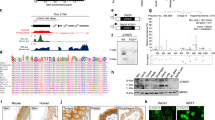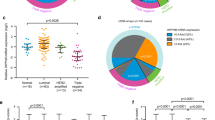Abstract
Aberrant activation of the canonical Wnt signal transduction pathway is involved in many diseases including cancer and is especially implicated in the development and progression of colorectal cancer. The key effector protein of the canonical Wnt pathway is β-catenin, which functions with T-cell factor/lymphoid enhancer factor to activate expression of Wnt target genes. In this study, we used a new functional screen based on cell survival in the presence of cDNAs encoding proteins that activate the Wnt pathway thus identifying novel Wnt signaling components. Here we identify carboxypeptidase E (|CPE) and its splice variant, ΔN-CPE, as novel regulators of the Wnt pathway. We show that whereas ΔN-CPE activates the Wnt signal, the full-length CPE (F-CPE) protein is an inhibitor of Wnt/β-catenin signaling. F-CPE forms a complex with the Wnt3a ligand and the Frizzled receptor. Moreover, F-CPE disrupts disheveled-induced signalosomes that are important for transducing the Wnt signal and reduces β-catenin protein levels and activity. Taken together, our data indicate that F-CPE and ΔN-CPE regulate the canonical Wnt signaling pathway negatively and positively, respectively, and demonstrate that this screening approach can be a rapid means for isolation of novel Wnt signaling components.
This is a preview of subscription content, access via your institution
Access options
Subscribe to this journal
Receive 50 print issues and online access
$259.00 per year
only $5.18 per issue
Buy this article
- Purchase on Springer Link
- Instant access to full article PDF
Prices may be subject to local taxes which are calculated during checkout








Similar content being viewed by others
References
Clevers H . Wnt/beta-catenin signaling in development and disease. Cell 2006; 127: 469–480.
Polakis P . Wnt signaling and cancer. Genes Dev 2000; 14: 1837–1851.
MacDonald BT, Tamai K, He X . Wnt/beta-catenin signaling: components, mechanisms, and diseases. Dev Cell 2009; 17: 9–26.
Tamai K, Semenov M, Kato Y, Spokony R, Liu C, Katsuyama Y et al. LDL-receptor-related proteins in Wnt signal transduction. Nature 2000; 407: 530–535.
Taelman VF, Dobrowolski R, Plouhinec JL, Fuentealba LC, Vorwald PP, Gumper I et al. Wnt signaling requires sequestration of glycogen synthase kinase 3 inside multivesicular endosomes. Cell 2010; 143: 1136–1148.
Cliffe A, Hamada F, Bienz M . A role of Dishevelled in relocating Axin to the plasma membrane during wingless signaling. Curr Biol 2003; 13: 960–966.
Schwarz-Romond T, Metcalfe C, Bienz M . Dynamic recruitment of axin by Dishevelled protein assemblies. J Cell Sci 2007; 120 (Pt 14): 2402–2412.
Bilic J, Huang YL, Davidson G, Zimmermann T, Cruciat CM, Bienz M et al. Wnt induces LRP6 signalosomes and promotes dishevelled-dependent LRP6 phosphorylation. Science 2007; 316: 1619–1622.
Zeng X, Huang H, Tamai K, Zhang X, Harada Y, Yokota C et al. Initiation of Wnt signaling: control of Wnt coreceptor Lrp6 phosphorylation/activation via frizzled, dishevelled and axin functions. Development 2008; 135: 367–375.
Metcalfe C, Mendoza-Topaz C, Mieszczanek J, Bienz M . Stability elements in the LRP6 cytoplasmic tail confer efficient signalling upon DIX-dependent polymerization. J Cell Sci 2010; 123 (Pt 9): 1588–1599.
Angers S, Moon RT . Proximal events in Wnt signal transduction. Nat Rev Mol Cell Biol 2009; 10: 468–477.
Cawley NX, Wetsel WC, Murthy SR, Park JJ, Pacak K, Loh YP . New roles of carboxypeptidase e in endocrine and neural function and cancer. Endocr Rev 2012; 33: 216–253.
Cool DR, Normant E, Shen F, Chen HC, Pannell L, Zhang Y et al. Carboxypeptidase E is a regulated secretory pathway sorting receptor: genetic obliteration leads to endocrine disorders in Cpe(fat) mice. Cell 1997; 88: 73–83.
Fricker LD, Snyder SH . Purification and characterization of enkephalin convertase, an enkephalin-synthesizing carboxypeptidase. J Biol Chem 1983; 258: 10950–10955.
Tang SS, Zhang JH, Liu HX, Li HZ . PC2/CPE-mediated pro-protein processing in tumor cells and its differentiated cells or tissues. Mol Cell Endocrinol 2009; 303: 43–49.
He P, Varticovski L, Bowman ED, Fukuoka J, Welsh JA, Miura K et al. Identification of carboxypeptidase E and gamma-glutamyl hydrolase as biomarkers for pulmonary neuroendocrine tumors by cDNA microarray. Hum Pathol 2004; 35: 1196–1209.
Horing E, Harter PN, Seznec J, Schittenhelm J, Buhring HJ, Bhattacharyya S et al. The ‘go or grow’ potential of gliomas is linked to the neuropeptide processing enzyme carboxypeptidase E and mediated by metabolic stress. Acta Neuropathol 2012; 124: 83–97.
Du J, Keegan BP, North WG . Key peptide processing enzymes are expressed by breast cancer cells. Cancer Lett 2001; 165: 211–218.
Murthy SR, Pacak K, Loh YP . Carboxypeptidase E: elevated expression correlated with tumor growth and metastasis in pheochromocytomas and other cancers. Cell Mol Neurobiol 2010; 30: 1377–1381.
Lee TK, Murthy SR, Cawley NX, Dhanvantari S, Hewitt SM, Lou H et al. An N-terminal truncated carboxypeptidase E splice isoform induces tumor growth and is a biomarker for predicting future metastasis in human cancers. J Clin Invest 2011; 121: 880–892.
Murthy SR, Lee TK, Cawley NX, Hewitt SM, Pacak K, Loh P (eds). An N-terminal truncated carboxypeptidase E splice isoform induces metastasis by activating NEDD9 and other metastasis inducing genes. AACR Annual Meeting 2012; Chicago, IL, 2012.
Staal FJ, Noort Mv M, Strous GJ, Clevers HC . Wnt signals are transmitted through N-terminally dephosphorylated beta-catenin. EMBO Rep 2002; 3: 63–68.
Golan T, Yaniv A, Bafico A, Liu G, Gazit A . The human Frizzled 6 (HFz6) acts as a negative regulator of the canonical Wnt. beta-catenin signaling cascade. J Biol Chem 2004; 279: 14879–14888.
Rowan AJ, Lamlum H, Ilyas M, Wheeler J, Straub J, Papadopoulou A et al. APC mutations in sporadic colorectal tumors: a mutational ‘hotspot’ and interdependence of the ‘two hits’. Pro Natl Acad Sci USA 2000; 97 (7): 3352–3357.
Fricker LD, Devi L . Posttranslational processing of carboxypeptidase E, a neuropeptide-processing enzyme, in AtT-20 cells and bovine pituitary secretory granules. J Neurochem 1993; 61: 1404–1415.
Felsenfeld G, Groudine M . Controlling the double helix. Nature 2003; 421: 448–453.
Park JJ, Koshimizu H, Loh YP . Biogenesis and transport of secretory granules to release site in neuroendocrine cells. J Mol Neurosci 2009; 37: 151–159.
Hausmann G, Banziger C, Basler K . Helping Wingless take flight: how WNT proteins are secreted. Nat Rev Mol Cell Biol 2007; 8: 331–336.
Strous GJ, Willemsen R, van Kerkhof P, Slot JW, Geuze HJ, Lodish HF . Vesicular stomatitis virus glycoprotein, albumin, and transferrin are transported to the cell surface via the same Golgi vesicles. J Cell Biol 1983; 97: 1815–1822.
Schwarz-Romond T, Fiedler M, Shibata N, Butler PJ, Kikuchi A, Higuchi Y et al. The DIX domain of Dishevelled confers Wnt signaling by dynamic polymerization. Nat Struct Mol Biol 2007; 14: 484–492.
Liu YT, Dan QJ, Wang J, Feng Y, Chen L, Liang J et al. Molecular basis of Wnt activation via the DIX domain protein Ccd1. J Biol Chem 2011; 286: 8597–8608.
Metcalfe C, Bienz M . Inhibition of GSK3 by Wnt signalling—two contrasting models. J Cell Sci 2011; 124 (Pt 21): 3537–3544.
Moeller C, Swindell EC, Kispert A, Eichele G . Carboxypeptidase Z (CPZ) modulates Wnt signaling and regulates the development of skeletal elements in the chicken. Development 2003; 130: 5103–5111.
Wang L, Shao YY, Ballock RT . Carboxypeptidase Z (CPZ) links thyroid hormone and Wnt signaling pathways in growth plate chondrocytes. J Bone Miner Res 2009; 24: 265–273.
Reznik SE, Fricker LD . Carboxypeptidases from A to z: implications in embryonic development and Wnt binding. Cell Mol Life Sci 2001; 58: 1790–1804.
Dobrowolski R, De Robertis EM . Endocytic control of growth factor signalling: multivesicular bodies as signalling organelles. Nat Rev Mol Cell Biol 2012; 13: 53–60.
Batlle E, Henderson JT, Beghtel H, van den Born MM, Sancho E, Huls G et al. Beta-catenin and TCF mediate cell positioning in the intestinal epithelium by controlling the expression of EphB/ephrinB. Cell 2002; 111: 251–263.
van de Wetering M, Sancho E, Verweij C, de Lau W, Oving I, Hurlstone A et al. The beta-catenin/TCF-4 complex imposes a crypt progenitor phenotype on colorectal cancer cells. Cell 2002; 111: 241–250.
Morin PJ, Sparks AB, Korinek V, Barker N, Clevers H, Vogelstein B et al. Activation of beta-catenin-Tcf signaling in colon cancer by mutations in beta-catenin or APC. Science 1997; 275: 1787–1790.
Acknowledgements
This work was supported by the Israel Science Foundation, by grant no. 20120016 from the Public Committee for Allocation of Estate Funds, Ministry of Justice, Israel, the Recanati Foundation, Israel Cancer Association through the Estate of the late Alexander Smidoda, US—Israel Binational Science Foundation and in part by the Intramural Research Program of the Eunice Kennedy Shriver National Institute of Child Health and Human Development to YPL.
Author information
Authors and Affiliations
Corresponding author
Ethics declarations
Competing interests
The authors declare no conflict of interest.
Additional information
Supplementary Information accompanies the paper on the Oncogene website
Rights and permissions
About this article
Cite this article
Skalka, N., Caspi, M., Caspi, E. et al. Carboxypeptidase E: a negative regulator of the canonical Wnt signaling pathway. Oncogene 32, 2836–2847 (2013). https://doi.org/10.1038/onc.2012.308
Received:
Revised:
Accepted:
Published:
Issue Date:
DOI: https://doi.org/10.1038/onc.2012.308
Keywords
This article is cited by
-
A CRISPR knockout screen reveals new regulators of canonical Wnt signaling
Oncogenesis (2021)
-
Klotho suppresses colorectal cancer through modulation of the unfolded protein response
Oncogene (2019)
-
The function of endocytosis in Wnt signaling
Cellular and Molecular Life Sciences (2018)
-
High-Temperature Requirement A1 (Htra1) - A Novel Regulator of Canonical Wnt Signaling
Scientific Reports (2017)
-
The effect of a germline mutation in the APC gene on β-catenin in human embryonic stem cells
BMC Cancer (2016)



